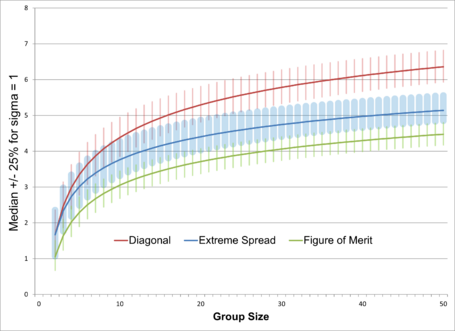Difference between revisions of "Range Statistics"
(→Example: NRA's Test Protocol) |
|||
| Line 38: | Line 38: | ||
With a little experimentation on our [[Media:RangeStatisticEstimation.xls|calculator]] we can see that this produces an estimate with a sampling error of 20% at a confidence level of 90%. So, for example, if the average extreme spread is reported at 1.0MOA then nine times out of ten we would expect that shooter, gun, and ammunition to produce five 5-shot groups with an average extreme spread between (0.8MOA, 1.2MOA). | With a little experimentation on our [[Media:RangeStatisticEstimation.xls|calculator]] we can see that this produces an estimate with a sampling error of 20% at a confidence level of 90%. So, for example, if the average extreme spread is reported at 1.0MOA then nine times out of ten we would expect that shooter, gun, and ammunition to produce five 5-shot groups with an average extreme spread between (0.8MOA, 1.2MOA). | ||
| + | |||
| + | This is surprisingly efficient given how much information is being discarded. Following the calculation methodology in [[Media:Confidence Interval Convergence.xlsx]]: If we actually knew the radius of all 25 shots our 90% confidence interval using the Rayleigh estimator would still have an sampling error of 18% -- practically no better than the 20% error here! | ||
Revision as of 16:49, 26 February 2014
Previous: Measuring Precision
Contents
Range Statistics
The three measures that vary with n (Extreme Spread, Diagonal, and Figure of Merit) are range statistics that lack convenient functional forms. However both the mean and standard deviation of their expected value, as well as quantiles, scale directly with σ, so it is sufficient to calculate those statistics once for σ = 1 and multiply the resulting values by the desired σ. Media:Sigma1RangeStatistics.xls contains quantiles and moments for n up to 100.
Example 1
What extreme spread should I expect for 5-shot groups from my rifle? The extreme spread median from the table for 5 shots is 3.0 σ. I've determined my rifle has precision σ = ½MOA. If I take five shots at 100 yards we would expect half my groups to be less than 3.0/2 = 1.5MOA \(\approx\) 1.6".
Multiplying the rest of the distribution data for that row by my 0.5MOA we can also say that the extreme spread of my 5-shot groups should exhibit the following distributions:
- 50% between (1.2, 1.8)MOA
- 80% between (1.0, 2.1)MOA
- 95% between (0.8, 2.4)MOA
Example 2
Over many tests I have found my rifle produces 5-shot groups with an average extreme spread of 1MOA. What extreme spread should I expect if I instead start shooting 10-shot groups? The table shows that the ratio of expected extreme spreads on 10-shot groups is 1.24 times the value on 5-shot groups. So my a priori expectation would be for 10-shot groups to average 1.24MOA.
Estimation
Following the Central Limit Theorem we can use the sampling distribution of the mean to make statistical inferences. The methods for this are detailed well by Kolbe. Suppose we want to estimate a gun's extreme spread. We need to specify three values:
- Shots per group, n – because range statistics increase with the number of shots taken
- Sampling Error, E – the distance (above and below, as a fraction of the estimated value) you allow your estimate to vary from the "true" value you would discover if you could average an infinite number of samples
- Confidence Level K – the likelihood your estimate will be within E of the true value
The number of groups g we need to shoot and measure in order to estimate the extreme spread ±E with confidence K is given by
- \(g = (\frac{Z V}{E})^2\)
where:
- V is the Coefficient of Variation, which is equal to the standard deviation divided by the mean for the given group size n in Media:Sigma1RangeStatistics.xls
- Z is the Critical Value associated with K, which is the inverse of the standard normal. The spreadsheet function for Z is
=NORMSINV(K + (1-K)/2)
The required data and formulas for this calculation can be found in Media:RangeStatisticEstimation.xls.
Efficient Estimators
If our goal is to characterize a range statistic using the least number of shots then we should pick our group size carefully. Kolbe et. al. noted that for any desired error and confidence level it looked like 7-shot groups produced a significant estimate using the lowest number of total shots fired. Using our more extensive simulations of the coefficient of variation we can see now that 6-shot groups are actually the most efficient, and that 5-shot groups are almost as efficient (and for many scenarios identical).
Example: NRA's Test Protocol
As noted previously, the NRA's standard for testing precision is to shoot five consecutive 5-shot groups and report the average extreme spread.
With a little experimentation on our calculator we can see that this produces an estimate with a sampling error of 20% at a confidence level of 90%. So, for example, if the average extreme spread is reported at 1.0MOA then nine times out of ten we would expect that shooter, gun, and ammunition to produce five 5-shot groups with an average extreme spread between (0.8MOA, 1.2MOA).
This is surprisingly efficient given how much information is being discarded. Following the calculation methodology in Media:Confidence Interval Convergence.xlsx: If we actually knew the radius of all 25 shots our 90% confidence interval using the Rayleigh estimator would still have an sampling error of 18% -- practically no better than the 20% error here!
